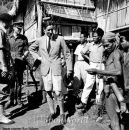We've tried to ensure the information displayed here is as accurate as possible. Should there be any inaccuracies, we would be grateful if you could let us know at info@ipohworld.org . All images and content are copyright.
(Please click on the thumbnail for a bigger image.)
Fort Brooke - Sir Donald MacGillivray, High Commissioner, Meets Pangoi
Thumbnail :

Subject :Fort Brooke - Sir Donald MacGillivray, High Commissioner, Meets Pangoi
Published By : None
Location : Pahang
Estimated Year : 1955
Media Type : Photograph
Source : Roy Follows, UK
Remark : Fort Brooke was deliberately situated right in the heart of enemy-controlled territory in order to enable the Police Jungle Company (reformed as the Police Field Force, PFF) to win over local hearts and minds and to track and attack the enemy suddenly and from close proximity.
Roy, as the Officer in Command of Fort Brooke during 1954/55, describes his role thus:
This photograph, courtesy of Roy Follows, was taken in Fort Brooke by an official government photographer. It shows Sir Donald MacGillivray, The High Commissioner (he took over from General Templer) together with his staff, meeting the notorious Pangoi (on the right). This demonstrates the importance of Pangoi as a surrendered terrorist.
To view details of Fort Brooke and Roy Follows click here.
To view details of Colonel A E Young and the strategy of the Jungle Forts, click here.
To read more about Jungle Forts and airstrips, click here.
To read more about Sir Donald MacGillivray, click here.
To read more about General Templer, click here.
For a short introduction to the Malayan Aborigines, click here.
Roy, as the Officer in Command of Fort Brooke during 1954/55, describes his role thus:
“Not only had I to try to 'win over' the hostile Aborigine tribes, but to speed this up. I also had to try and 'neutralize,' two senior Communist Terrorists (CTs) who each, with their armed units, controlled the Aborigines in the area.
One with the theatrical name of Fun Ming (no relation to Ah Ming, Commander 9th Platoon, Johor was in charge of the CTs Asali - Aborigine organization - for the whole region.
The other was Pangoi, a domineering tribal headman who, it was claimed, had along with Fun Ming been involved in a number of ambushes against the Security Forces(SFs).
Fun Ming and Pangoi, having known each other since before the emergency, had become firm friends over the years. Consequently Fun Ming, through having such a powerful ally in Pangoi, gave the CTs control over the Aborigines.
One thing to my advantage was that Pangoi’s tribal settlement was only a few miles west of Fort Brooke, and most days some of his people, including his son Uda, would come into the fort. Using his son as a go between, I would send Pangoi small gifts, usually of tobacco, along with a verbal message suggesting that we arrange to meet. Also with his ladang (Aboriginal tribal settlement consisting of about four or five longhouses) being not too far away, with a small patrol I did make a couple of surprise visits there, in the slim chance of 'nailing' him. But each time we arrived there, we found the place had been quickly evacuated.
We also knew that as we made our way amongst the empty longhouses, unseen eyes were watching our every move. What added to this eerie tension, was that I aware that Fun Ming and his unit were regular visitors, and Pangoi’s men had number of firearms, as well as blowpipes that deliver a near silent poisonous dart - there was no known antidote to that poison, and death took an agonising hour or more. With this in mind. and being only a small patrol I would pull out.
I did attack Fun Ming's camp on one occasion but sad to say he and all his unit escaped. But in the end I am pleased to say that the tyrannical Pangoi surrendered to me.”
This photograph, courtesy of Roy Follows, was taken in Fort Brooke by an official government photographer. It shows Sir Donald MacGillivray, The High Commissioner (he took over from General Templer) together with his staff, meeting the notorious Pangoi (on the right). This demonstrates the importance of Pangoi as a surrendered terrorist.
To view details of Fort Brooke and Roy Follows click here.
To view details of Colonel A E Young and the strategy of the Jungle Forts, click here.
To read more about Jungle Forts and airstrips, click here.
To read more about Sir Donald MacGillivray, click here.
To read more about General Templer, click here.
For a short introduction to the Malayan Aborigines, click here.
Filename : 20091108-004